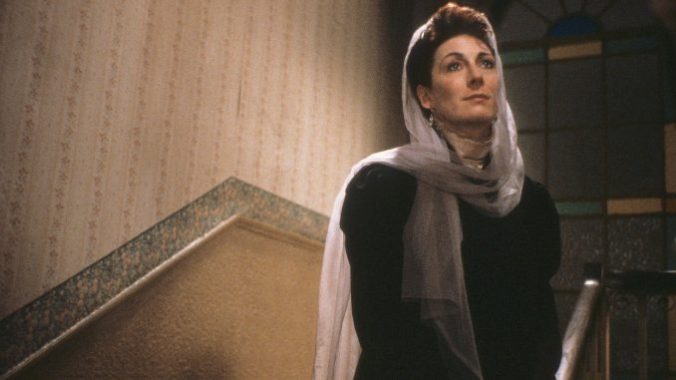John Huston’s Last Masterpiece: The Dead, 35 Years Later

“It was always a great affair, Miss Morkan’s annual dance….” The snow is falling as the guests arrive. Cousins, nieces and nephews, friends of the family—it is the annual Christmastime party. Arriving late are Gabriel and Gretta Conroy, the former of whom becomes something of a protagonist in a deceptively simple story, as he comes to a revelation about his own insignificance.
There is “The Dead,” the short story by James Joyce published in his breakout early collection Dubliners, and then there is The Dead, the final film of Hollywood maverick John Huston, who made a career of adaptation. While legendarily considered unfilmable, the two pieces are remarkably similar while still being of different focuses by their respective artists, one being an examination or even imagination of later life by a young man at the start of what he hoped would be a significant career, and the other a last minute work of reflection by a dying man who wouldn’t live to see his film released some 35 years ago.
At the party there is dancing, drinking and amusements before dinner. We get to know our turn-of-the-century, Irish, middle-class characters through their passing interactions with one another, their behind-the-back anecdotes, bits of rumors and slight embarrassments. There is the alcoholic Freddy Malins whose overbearing mother got him to take the teetotaler’s pledge—which he has already broken tonight—at the start of the new year. There is Mr. Brown, the high-minded Protestant who thinks little of Freddy, but can’t help his own drinking. There’s Aunt Kate and Julia, the aging hostesses, and their talented pianist niece Mary Jane. And of course there’s the Conroys. We get little idea of Gretta at first. She spends most of the party in quiet appreciation and at times will become oddly distant. But Gabriel, the part-time writer who’s meant to give the big dinner toast, sees himself as needing to be the most welcoming and cordial of all the guests.
Gabriel is in many ways a European man more than an Irishman. The housekeeper Lily comments on his strange boots, and he tells her that galoshes are very popular on the continent. He writes a literary review column for a British-owned newspaper, which gets the young revolutionary Miss Molly Ivors to call him a West Briton—a harsh put-down at the time, claiming he favors the rule of those on the other side of the Irish Sea. Gabriel is confused by all of this. He is quite bored with Ireland but still sees himself as a politically moderate figure, a neutral party in a polarized time. In fact, most things about Gabriel are middling. He is a crowd pleaser, a man of liberal sentiment who won’t take too harsh an opinion of anyone or anything, ultimately without passion.
When they’re going to leave the party, Gabriel catches a glimpse of Gretta struck in a trance at the top of the stairs, lost in memory as a song echoes through the halls. He confronts her when they get home; she reveals that song, “The Lass of Aughrim,” used to be sung to her by her first love, Michael Furey, a young boy from her days in Galway. Michael was in declining health when they first met, but Gretta believes she killed him. One night before she was off to the convent, she heard a tapping at her window. It was Michael, standing in the rain to see her one last time. She implored him to go home before the weather took him, but he refused. He died soon after, at 17. Gabriel comes to realize that he has never felt for his wife what that young boy did, and how poor a part he’s played in all their years. As he’s coming to terms with the insignificance his life has amounted to, he looks out the window to see the snow falling over all of Ireland that night.
That is The Dead, both Joyce’s and Huston’s. “The story is about a man being revealed to himself and we’re being revealed to ourselves…What we think we are and what we are are two different things…and the discovery of that can be pretty unsettling,” as Huston would put it. But it’s in the finer details in his film that separates it from Joyce’s story.
Tony Huston, John’s eldest son, felt he had much to prove to his father in adapting the script. Having spent his screenwriting career in the world of schlock, going in on an unfilmable story would be a serious challenge. The film would be just as personal for Tony as for his father; during the writing process, he was still reeling from the shock of his wife telling him she didn’t want him to come home—that she had fallen out of love with him. Still, through all the pressure and tumult, Tony proved to be successful and even got an Academy Award nomination for his efforts (this was also Tony’s last screenplay to be filmed before switching careers). In order to condense and refocus the story, Tony first and foremost de-emphasized the political dialogue. What was hot-button during its original publication (only a few years before the Irish Revolution) became part of the detailed period texture that colors Huston’s work. But the most important change comes from the way perspective is used, both in context of the artists behind the works and within the works themselves.
-

-

-

-

-

-

-

-

-

-

-

-

-

-

-

-

-

-

-

-

-

-

-

-

-

-

-

-

-

-

-

-

-

-

-

-

-

-

-

-








































